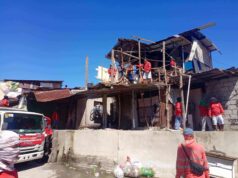“WE ARE expressing our appreciation to President Aquino for his broadmindedness in issuing two executive orders that outlined the present administration’s thrust to pursue a more liberalized civil aviation policy in the country.”
So exulted Councilor Jay Sangil upon the recent approval of an Angeles City Council resolution lauding the President for implementing a so-called “pocket open skies policy” expected to bring in more flights to the Diosdado Macapagal International Airport at Clark.
P-Noy recently signed EO 28 that reorganized the Philippine Air Negotiating Panel and the Philippine Air Consultation Panel, and EO 29 ordering these two panels “to pursue more aggressively” the international civil aviation liberalization policy.
Sangil incisively notes: “The most salient part of EO 29 is its provision allowing the Civil Aeronautics Board (CAB) to grant any foreign airline the right to operate in the country’s other airports other than NAIA. This means that foreign airlines who have been wanting to fly in and out of Clark airport may now do so without the need to undergo the tedious negotiation process of air services agreements or ASAs.”
The flocking of foreign airlines at DMIA, Sangil sees, “may bring about the Second Wind we have been waiting for to finally bring Clark to its rightful status as the country’s premier international gateway.”
It was in 2004, Sangil noted, that Clark’s “First Wind” came about when the national government’s air liberalization policies started to have its beneficial effects on Clark airport’s development as a viable gateway.
From a nesting stop of migratory birds, as was the joke then, DMIA started being a serious gateway for travellers around the Asian region.
Sangil distinctly remembers – as if it were but yesterday – that it was South Korea’s Asiana Airlines that blew the sails of the DMIA with the average daily international passenger traffic at Clark climbing to as much as 135.
Then in early 2005, low cost carriers (LCCs) Air Asia Berhad of Malaysia and Tiger Airways of Singapore came, followed by our very own Cebu Pacific Air in late 2008, further boosting international passenger traffic to 1,750 per day.
“Without a doubt, the entry and operation of these international airlines at Clark, and the spectacular growth international travellers using the airport, was only made possible by the presence of liberalized aviation policies that government started implementing in 2005.” So definitive is Sangil in his conclusion there.
So we all join Sangil in singing hallelujah to P-Noy?
Not quite yet. If we go by the record of Presidents opening RP’s, er PHL’s, skies.
In January 2006, President Gloria Macapagal-Arroyo signed Executive Order 500 unilaterally proclaiming an open skies policy at Clark.
We remember GMA’s act heralded by George Rushford in his Wall Street Journal-Asia column thus: “the move unleashed the forces of liberalization at Clark by allowing foreign airlines to fly in hundreds of thousands of tourists from Korea, Singapore, Hong Kong, Macau, Malaysia and as far as Dubai. It also opened the door to all the trade that could be conducted via the cargo holds of such airlines.”
Alas, only seven months after her glorious act of opening the skies, the President apparently succumbed to pressures from “domestic protectionist allies” – read: the Imperial Manila dragons – in the aviation industry and amended EO 500 with EO 500-A, effectively slowing down, nay, nearly grounding to a halt, airline traffic and limited foreign airline’s access to the Diosdado Macapagal International Airport (DMIA) and the Subic International Airport.
Livid, we wrote here then: “But for the Imperial Dragons, everybody – from the local stakeholders to the Joint Foreign Chambers of the Philippines – agrees that the key to unleashing the full potential of the DMIA as an engine of national economic growth and development is an open skies policy…”
“The presidential declaration of the DMIA as the country’s premier international gateway is a total absurdity without an open skies policy. That, any idiot can see.
The opposition to the open skies policy is grounded solely on vested, personal, selfish interests. That, any idiot can also see.
It is to the national interest that the President should subscribe to, no matter the matter with those “domestic protectionist allies” of hers.”
Dead at its birthing in effect was GMA’s EO 500. So the Imperial Dragons decreed. Can P-Noy’s EOs 28 and 29 fare any better?
Keep the celebrations on hold – as yet – Honorable Sangil.
So exulted Councilor Jay Sangil upon the recent approval of an Angeles City Council resolution lauding the President for implementing a so-called “pocket open skies policy” expected to bring in more flights to the Diosdado Macapagal International Airport at Clark.
P-Noy recently signed EO 28 that reorganized the Philippine Air Negotiating Panel and the Philippine Air Consultation Panel, and EO 29 ordering these two panels “to pursue more aggressively” the international civil aviation liberalization policy.
Sangil incisively notes: “The most salient part of EO 29 is its provision allowing the Civil Aeronautics Board (CAB) to grant any foreign airline the right to operate in the country’s other airports other than NAIA. This means that foreign airlines who have been wanting to fly in and out of Clark airport may now do so without the need to undergo the tedious negotiation process of air services agreements or ASAs.”
The flocking of foreign airlines at DMIA, Sangil sees, “may bring about the Second Wind we have been waiting for to finally bring Clark to its rightful status as the country’s premier international gateway.”
It was in 2004, Sangil noted, that Clark’s “First Wind” came about when the national government’s air liberalization policies started to have its beneficial effects on Clark airport’s development as a viable gateway.
From a nesting stop of migratory birds, as was the joke then, DMIA started being a serious gateway for travellers around the Asian region.
Sangil distinctly remembers – as if it were but yesterday – that it was South Korea’s Asiana Airlines that blew the sails of the DMIA with the average daily international passenger traffic at Clark climbing to as much as 135.
Then in early 2005, low cost carriers (LCCs) Air Asia Berhad of Malaysia and Tiger Airways of Singapore came, followed by our very own Cebu Pacific Air in late 2008, further boosting international passenger traffic to 1,750 per day.
“Without a doubt, the entry and operation of these international airlines at Clark, and the spectacular growth international travellers using the airport, was only made possible by the presence of liberalized aviation policies that government started implementing in 2005.” So definitive is Sangil in his conclusion there.
So we all join Sangil in singing hallelujah to P-Noy?
Not quite yet. If we go by the record of Presidents opening RP’s, er PHL’s, skies.
In January 2006, President Gloria Macapagal-Arroyo signed Executive Order 500 unilaterally proclaiming an open skies policy at Clark.
We remember GMA’s act heralded by George Rushford in his Wall Street Journal-Asia column thus: “the move unleashed the forces of liberalization at Clark by allowing foreign airlines to fly in hundreds of thousands of tourists from Korea, Singapore, Hong Kong, Macau, Malaysia and as far as Dubai. It also opened the door to all the trade that could be conducted via the cargo holds of such airlines.”
Alas, only seven months after her glorious act of opening the skies, the President apparently succumbed to pressures from “domestic protectionist allies” – read: the Imperial Manila dragons – in the aviation industry and amended EO 500 with EO 500-A, effectively slowing down, nay, nearly grounding to a halt, airline traffic and limited foreign airline’s access to the Diosdado Macapagal International Airport (DMIA) and the Subic International Airport.
Livid, we wrote here then: “But for the Imperial Dragons, everybody – from the local stakeholders to the Joint Foreign Chambers of the Philippines – agrees that the key to unleashing the full potential of the DMIA as an engine of national economic growth and development is an open skies policy…”
“The presidential declaration of the DMIA as the country’s premier international gateway is a total absurdity without an open skies policy. That, any idiot can see.
The opposition to the open skies policy is grounded solely on vested, personal, selfish interests. That, any idiot can also see.
It is to the national interest that the President should subscribe to, no matter the matter with those “domestic protectionist allies” of hers.”
Dead at its birthing in effect was GMA’s EO 500. So the Imperial Dragons decreed. Can P-Noy’s EOs 28 and 29 fare any better?
Keep the celebrations on hold – as yet – Honorable Sangil.



